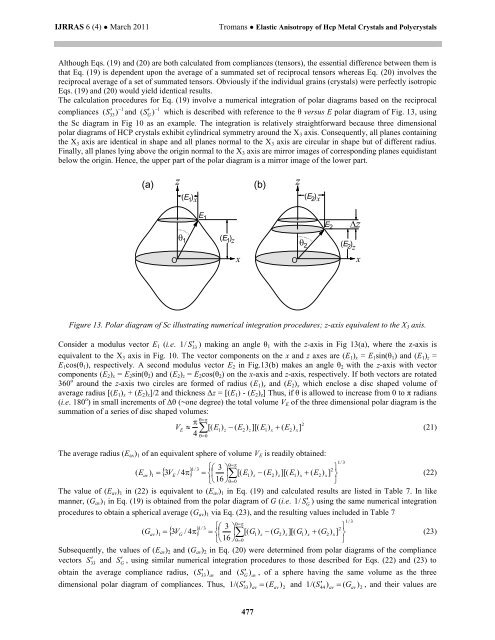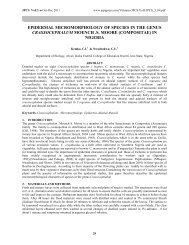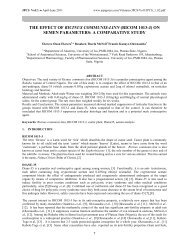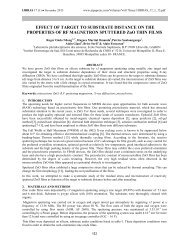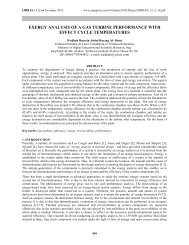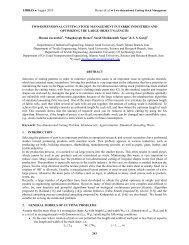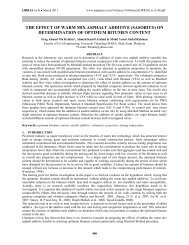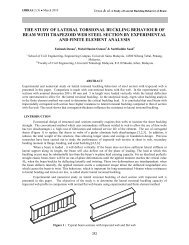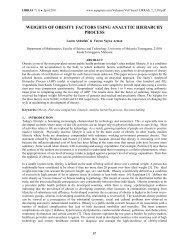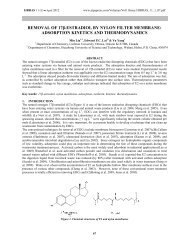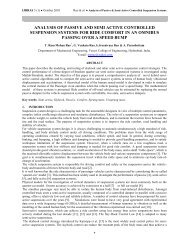elastic anisotropy of hcp metal crystals and polycrystals
elastic anisotropy of hcp metal crystals and polycrystals
elastic anisotropy of hcp metal crystals and polycrystals
Create successful ePaper yourself
Turn your PDF publications into a flip-book with our unique Google optimized e-Paper software.
IJRRAS 6 (4) ● March 2011 Tromans ● Elastic Anisotropy <strong>of</strong> Hcp Metal Crystals <strong>and</strong> Poly<strong>crystals</strong><br />
Although Eqs. (19) <strong>and</strong> (20) are both calculated from compliances (tensors), the essential difference between them is<br />
that Eq. (19) is dependent upon the average <strong>of</strong> a summated set <strong>of</strong> reciprocal tensors whereas Eq. (20) involves the<br />
reciprocal average <strong>of</strong> a set <strong>of</strong> summated tensors. Obviously if the individual grains (<strong>crystals</strong>) were perfectly isotropic<br />
Eqs. (19) <strong>and</strong> (20) would yield identical results.<br />
The calculation procedures for Eq. (19) involve a numerical integration <strong>of</strong> polar diagrams based on the reciprocal<br />
1<br />
1<br />
compliances ( S33) <strong>and</strong> ( S G ) which is described with reference to the θ versus E polar diagram <strong>of</strong> Fig. 13, using<br />
the Sc diagram in Fig 10 as an example. The integration is relatively straightforward because three dimensional<br />
polar diagrams <strong>of</strong> HCP <strong>crystals</strong> exhibit cylindrical symmetry around the X3 axis. Consequently, all planes containing<br />
the X3 axis are identical in shape <strong>and</strong> all planes normal to the X3 axis are circular in shape but <strong>of</strong> different radius.<br />
Finally, all planes lying above the origin normal to the X3 axis are mirror images <strong>of</strong> corresponding planes equidistant<br />
below the origin. Hence, the upper part <strong>of</strong> the polar diagram is a mirror image <strong>of</strong> the lower part.<br />
(a) z<br />
(b)<br />
O<br />
(E 1)<br />
x<br />
1<br />
E<br />
1<br />
(E )<br />
1 z<br />
x<br />
Figure 13. Polar diagram <strong>of</strong> Sc illustrating numerical integration procedures; z-axis equivalent to the X3 axis.<br />
Consider a modulus vector E1 (i.e. 1/ S 33 ) making an angle θ1 with the z-axis in Fig 13(a), where the z-axis is<br />
equivalent to the X3 axis in Fig. 10. The vector components on the x <strong>and</strong> z axes are (E1)x = E1sin(θ1) <strong>and</strong> (E1)z =<br />
E1cos(θ1), respectively. A second modulus vector E2 in Fig.13(b) makes an angle θ2 with the z-axis with vector<br />
components (E2)x = E2sin(θ2) <strong>and</strong> (E2)z = E2cos(θ2) on the x-axis <strong>and</strong> z-axis, respectively. If both vectors are rotated<br />
360 o around the z-axis two circles are formed <strong>of</strong> radius (E1)x <strong>and</strong> (E2)x which enclose a disc shaped volume <strong>of</strong><br />
average radius [(E1)x + (E2)x]/2 <strong>and</strong> thickness Δz = [(E1) - (E2)z] Thus, if θ is allowed to increase from 0 to π radians<br />
(i.e. 180 o ) in small increments <strong>of</strong> Δθ (~one degree) the total volume VE <strong>of</strong> the three dimensional polar diagram is the<br />
summation <strong>of</strong> a series <strong>of</strong> disc shaped volumes:<br />
<br />
2<br />
V E [( E1<br />
) z ( E2)<br />
z][(<br />
E1)<br />
x ( E2)<br />
x]<br />
(21)<br />
4<br />
0<br />
477<br />
O<br />
z<br />
2<br />
(E 2)<br />
x<br />
The average radius (Eav)1 <strong>of</strong> an equivalent sphere <strong>of</strong> volume VE is readily obtained:<br />
1/<br />
3 <br />
3 <br />
2<br />
( ) 1 3 / 4<br />
<br />
[(<br />
1)<br />
( 2)<br />
][( 1)<br />
( 2)<br />
] <br />
16<br />
0<br />
<br />
<br />
E av VE<br />
E z E z E x E x<br />
(22)<br />
<br />
The value <strong>of</strong> (Eav)1 in (22) is equivalent to (Eav)1 in Eq. (19) <strong>and</strong> calculated results are listed in Table 7. In like<br />
manner, (Gav)1 in Eq. (19) is obtained from the polar diagram <strong>of</strong> G (i.e. 1 / S G ) using the same numerical integration<br />
procedures to obtain a spherical average (Gav)1 via Eq. (23), <strong>and</strong> the resulting values included in Table 7<br />
1/<br />
3 <br />
3 <br />
2<br />
( ) 1 3 / 4<br />
<br />
[(<br />
1)<br />
( 2)<br />
][( 1)<br />
( 2)<br />
] <br />
16<br />
0<br />
<br />
<br />
G av VG<br />
G z G z G x G x<br />
<br />
(23)<br />
Subsequently, the values <strong>of</strong> (Eav)2 <strong>and</strong> (Gav)2 in Eq. (20) were determined from polar diagrams <strong>of</strong> the compliance<br />
vectors S 33 <strong>and</strong> S G , using similar numerical integration procedures to those described for Eqs. (22) <strong>and</strong> (23) to<br />
obtain the average compliance radius, ( S 33)<br />
av <strong>and</strong> ( S G)<br />
av , <strong>of</strong> a sphere having the same volume as the three<br />
dimensional polar diagram <strong>of</strong> compliances. Thus, 1/( S 33 ) av ( Eav)<br />
2 <strong>and</strong> 1/( S 44 ) av ( Gav)<br />
2 , <strong>and</strong> their values are<br />
E<br />
2<br />
z<br />
(E )<br />
2 z<br />
1/<br />
3<br />
1/<br />
3<br />
x


